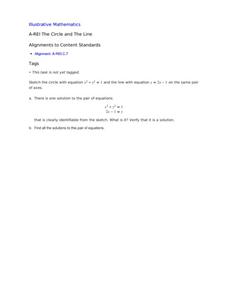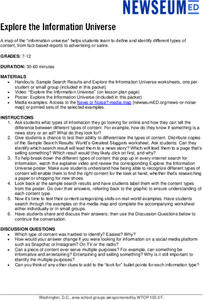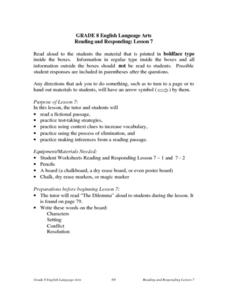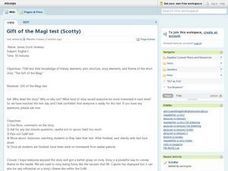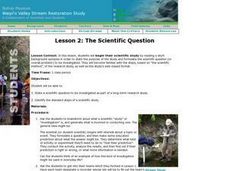Illustrative Mathematics
The Circle and The Line
Here is a resource where algebra learners show their understanding of a system of equations involving a circle and a line. Once graphed, learners see two points of intersection, one where the ordered pair is read, and a second where...
EngageNY
From Equations to Inequalities
Sometimes, equality just doesn't happen. Scholars apply their knowledge of solving equations to identify values that satisfy inequalities in the 34th installment of a 36-part module. They test given sets of numbers to find those that are...
Mathematics Assessment Project
Sorting Equations and Identities
Identify the identity. Learners first solve equations to find the number of solutions. Scholars then determine if given equations are always, sometimes, or never true, leading to the concept of identities.
Laboratory for Atmospheric and Space Physics
Planetary Distances on the Playground
There's no need to stay inside; get out of the classroom and create a scaled map of the solar system on your playground field! In collaborative groups, scholars identify the distance between the sun and other planets, place planet...
Curated OER
Is Our Water Healthy?
High schoolers test water for a least one chemical characteristic. They hypothesize how a storm event might change the chemical characteristics of a stream. Students collect water samples and use the chemical test to test the water.
Virginia Department of Education
Freshwater Food Chains
What's in the water? Encourage your class to further explore this question and learn about pond ecosystems, food chains, and food webs as they complete this hands-on activity. They view the environment from a new perspective...
Curated OER
Kids' Newsbreaks
Group learners together to identify a question relating to an issue and create a 60-second kids news break highlighting information that begins to answer the question. They research and answer issue questions in a news story format.
Nemours KidsHealth
Concussions: Grades 6-8
Teach middle schoolers to learn how to prevent concussions, recognize the symptoms of a concussion, and what they should do in case of a concussion. After reading articles that provide background information, groups create factsheets...
Newseum
Explore the Information Universe
Distinguishing among different types of content when conducting online searches can be a challenge. An informative resource helps researchers identify different types of content, from fact-based reports to ads, from propaganda to satire....
Curated OER
Kitchen Introduction Unit Test
Students complete a test demonstrating their knowledge of kitchen safety, sanitation, equipment, measuring, cooking terms, abbreviations, substitutions, equivalents, reading and parts of a recipe, and the microwave oven.
Curated OER
Reading and Responding -- Lesson 7
Fourth graders work individually or in a small group to (1) read a nonfictional selection, (2) identify main idea and details, (3) identify the author's purpose, and (4) practice test-taking strategies.
Curated OER
Minerals
Students apply rules to compare and rank the hardness and softness of minerals. They perform a scratch test on four unknown mineral samples, read a bar graph that illustrates the comparative hardness and softness of four named minerals,...
Curated OER
Using Primary Source Documents in the Classroom
Students use primary documents to explore the past. They consider the source of the documents and identify and biases that the author may have held. They identify any questions about the historical event that may remain after reading the...
American Chemical Society
Temperature and the Rate of a Chemical Reaction
Putting glow sticks in the freezer makes them last longer, but why is that? Lesson focuses on how temperature impacts the rate of a chemical reaction. It begins with a teacher demonstration, then scholars design their own experiments...
Curated OER
Identifying Food Nutrients
Young scholars pretend they are a food-quality tester. They develop a kit to test food for sugars, starches, proteins and lipids. They answer questions to complete the lesson.
Curated OER
Genetic Testing for Disease Susceptibility
Students explore how testing for particular genetic variations can help people to make decisions in lifestyle and health care choices. They analyze a Web-based case study, participate in class discussion, view video segments and...
Curated OER
Testing For Congruent Triangles
Students define and discuss congruency and the corresponding parts between congruent triangles. They create a pair of congruent triangles, test for congruency, and complete a worksheet.
Curated OER
Meat Test
Students explore basics of meat, meat cookery, and preparation skills and techniques in safe handling procedure. Students state qualities or advantages of casserole, identify parts of casserole, food ingredients, function of...
Curated OER
Gift of the Magi Test
Students explore literary elements, plot structure, and story elements. They read "The Gift of the Magi," and identify its theme and elements of the story. Afterward, students discuss the story and take a test over the material studied.
Curated OER
Mitty Test and Theme
Students read stories and determine the stock characterization, static/dynamic characterization and direct/indirect characterization. They read the story of "Mitty Test, "answer questions regarding the story, and discuss the themes of...
Curated OER
Identifying Fragments
In this identifying fragments worksheet, students label sentences and fragments and revise fragments. Students complete twenty three fill in the blank and short answer questions.
Curated OER
Identifying Creatures
Young scholars use a classification key from a provided worksheet to identify creatures. This task assesses student's abilities to interpret data, make decisions, identify, and classify.
Curated OER
The Scientific Question
Students identify the steps in the scientific method and discuss how each step is implemented. They examine a study of a stream on Kaua'i and analyze the scientific method in action.
Curated OER
Identifying Acids and Bases
Sixth graders observe the physical and chemical change that can occur in an acid and a base. In this acids and bases lesson plan, 6th graders use cabbage juice to identify, compare, and contrast acids and bases.
